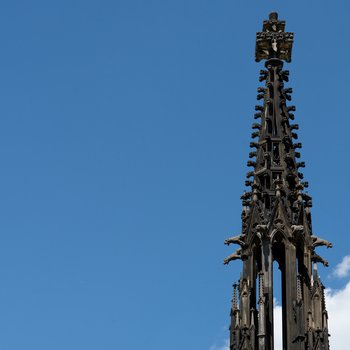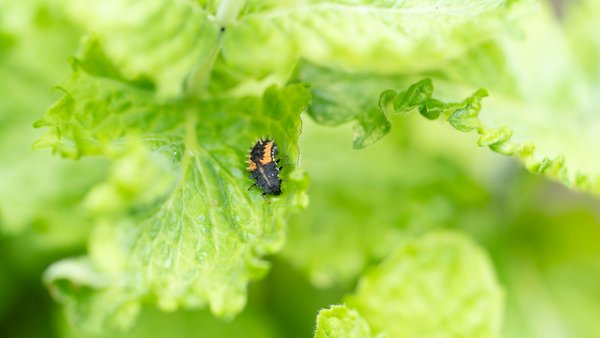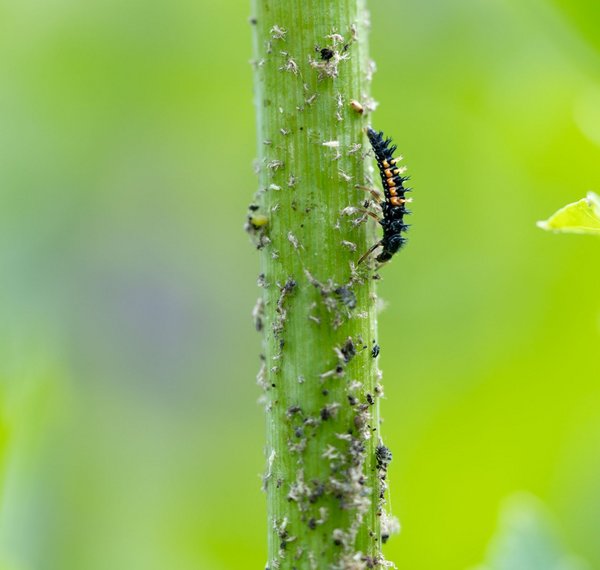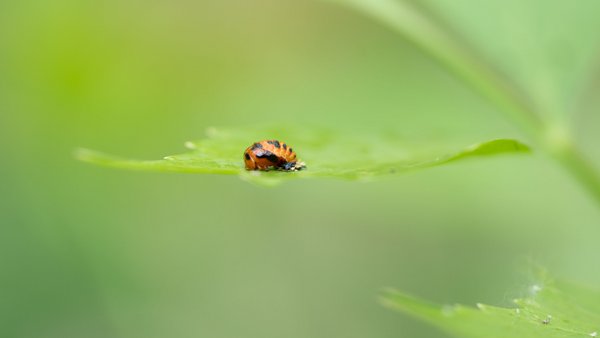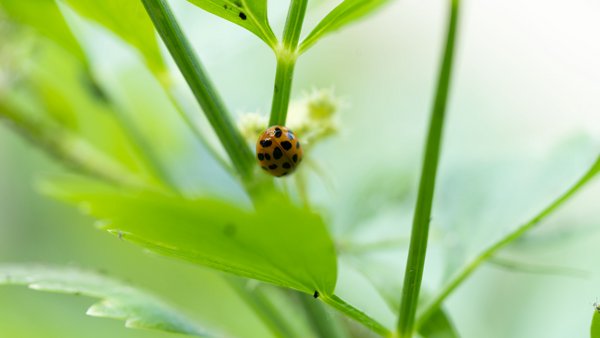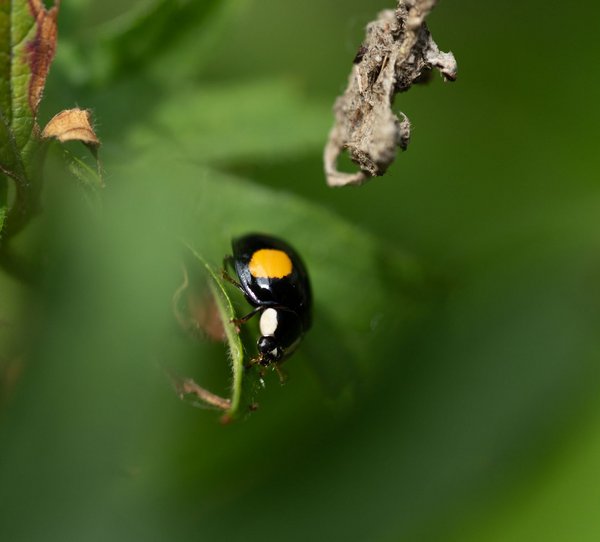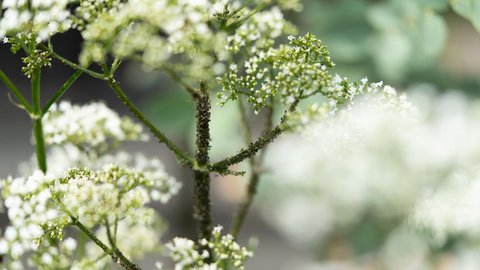
Blattlausbefall im Japanischen Palais.
© Staatliche Kunstsammlungen Dresden, Foto: Jacob Franke
Making a Jurassic meal of it
Let’s start with some basic facts. Aphids’ amazing survival strategies have kept them thriving on our planet for a good 200 million years. That means they were already around when dinosaurs roamed the Earth. Altogether, there are 5,000 sap-sucking species, 800 of which live in central Europe. As the sheer number of hungry insects drinking from a plant can damage and weaken it considerably, they are largely viewed as pests. However, on our complex planet, things are not quite that simple: one creature’s loss is another’s gain, and the aim is to maintain a balance somehow.
In the case of aphids, it all starts with an egg; or at least, it does if our story begins at the start of the gardening year. Each egg hatches into a female. These newly hatched female aphids then reproduce spontaneously, through parthenogenesis, i.e. with no need for a male partner. During that initial period, they produce up to forty live female young. It is not until the end of the season, as winter approaches, that male aphids are born again, enabling them to mate and produce stronger eggs that will survive the winter.
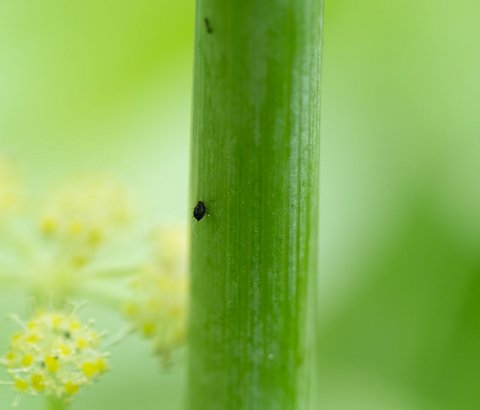
Eine einzelne Blattlaus.
© Staatliche Kunstsammlungen Dresden, Foto: Jacob Franke
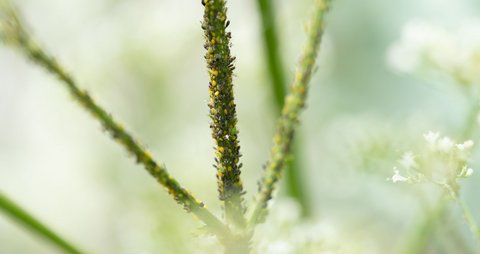
Grüne und schwarze Blattläuse
© Staatliche Kunstsammlungen Dresden, Foto: Jacob Franke
Just like every other living being, aphids want to survive. That means they neither want to kill their host plant nor fall prey to their natural predators. And they use a fascinating strategy to avoid those threats. When too many aphids have colonised a plant, or when ladybird larvae sniff them out and start munching through the aphids, they release pheromones that cause winged offspring to start being born. They can thus fly off to other plants, where they can happily continue their sap-sucking.
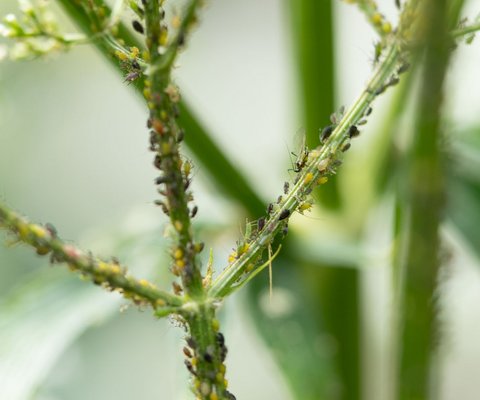
Nachdem die Marienkäferlarven anfangen ihre Arbeit zu tun, werden Blattläuse mit Flügeln geboren, um sich auf eine andere Wirtspflanze zu flüchten.
© Staatliche Kunstsammlungen Dresden, Foto: Jacob Franke
Sucking is not quite the right word, however: in fact, they penetrate the veins of leaves with their mouthparts and the sap that comes out flows into the aphids’ little bodies, feeding them with no action on their part. As this actually provides far more sugar and water than the aphid needs, the mixture is excreted as a clear, sticky liquid: honeydew. This, in turn, is an important source of food for ants and honeybees. And as the ants love to eat honeydew so much, they live in a kind of symbiotic relationship with the aphids, “farming” and “milking” them and protecting them from their natural predators – or at least trying to do so.
Honeydew is not the only thing that is an important food source, however: many animals feed on the aphids themselves – ladybirds, lacewings, hoverflies, parasitic wasps, snails and various species of birds. Although aphids are often seen purely as a pest by human beings, they are an important link in the food chain.
Out of these aphid-loving predators, let’s take a look at ladybirds, as they played a key role in clearing up much of the infestation that plagued the Japanisches Palais. Little ladybird larvae eat between 600 and 800 aphids before they turn into beetles. From then on, they eat 50 to 150 aphids a day. That’s a lot.
Aphids can also transmit diseases and viruses from one plant to another, severely damaging or even killing plants. This year, the weather conditions were particularly favourable for aphids: the year began with a few mild weeks that enabled the insects to hatch. The cold snap that followed meant the ladybirds hibernated a little longer than usual, giving the aphids plenty of time to reproduce without hindrance. At the Japanisches Palais, the elderflower suffered especially badly; it has still not recovered from the peak of the infestation in May and June.
Basically, all you have to do is wait for the beneficial bugs to arrive, but if the colonies in the garden become too bothersome in the meanwhile, you can try to wash the aphids off with a powerful jet of water. There are also various ecological home remedies that can help, but the most effective step is to have a wide variety of ecologically valuable plants that provide enough food for various beneficial bugs. And to put it very simply, the healthier a plant is, the better it can withstand stress. When gardening, you thus need to make sure plants have a good supply of water and nutrients (at the Japanisches Palais, we swear by worm composting). The cycle then balances itself out and you can sit back and watch this fascinating spectacle.
Also of interest:
Winter at the Palais Garden #1 - The Worm Compost
While migratory birds spend their vacations under palm trees and others completely avoid being awake during the cold season, the in-house worms of the Palais Garden are already preparing for spring.
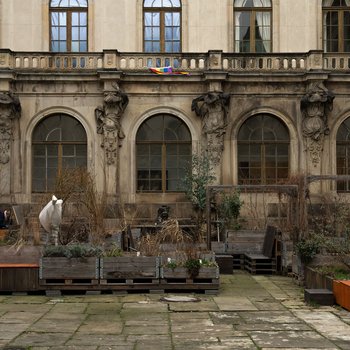
The manifesto of phyto-centred design
Inspired by ongoing initiatives and projects of contemporary international designers, engineers, artists and writers, the following phyto-based actions are not addressed solely to practitioners, but call for everyone's (including producers’ and consumers’) sense of respect, responsibility, equity and empathy towards plants. They should be read not as rules but as invitations to see the world through the perspective of plants.
![[Translate to English:]](/fileadmin/_processed_/7/e/csm_Plant_Fever_The_Manifesto_of_Phyto-centred_Design_Photo__c__Olly_Cruise__studio_d-o-t-s_-_Horizontal_cut_High_Res_96813b1039.jpg)
The Cholerabrunnen in Dresden
From 1840 to 1841, the city of Dresden escaped an outbreak of cholera, probably thanks to measures that had been taken. Shortly after, on 5 November 1841, Captain Eugen Freiherr von Gutschmid, a baron, art patron and honorary member of the Royal Saxon Academy of the Arts, commissioned the architect Gottfried Semper to design and build a monument to the event in “Gothic style”; the architectural style to which Gutschmid himself was most attached.
